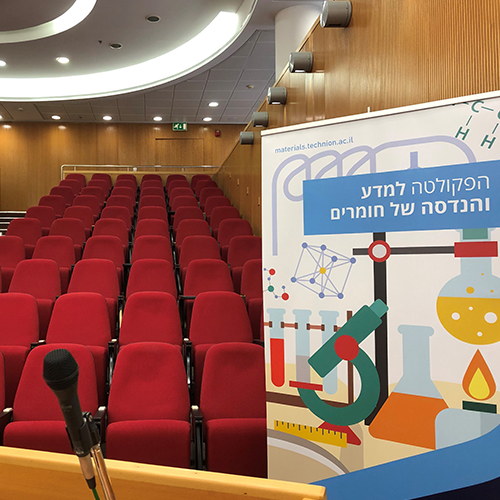
11/07/2025
אודיטוריום ע"ש דויד וואנג, בניין מידן, קומה 3
Ms. Shiri Maoz, PhD Candidate
Interdepartmental Program in Polymer Engineering, Technion – Israel Institute of Technology, Haifa
I received a BSc and an MSc in Chemistry from the Hebrew University in Jerusalem. I then worked in industry in various fields for 10 years (polymers and petrochemical) and returned to undertake a PhD to receive a deeper understanding of polymers and of science in general.
PolyHIPEs are porous polymers templated within high internal phase emulsions (HIPEs). Polymer foams are porous polymers generated through gas expansion during polymer solidification. The objective of this work is to combine chemical foaming and water-in-oil emulsion templating using step growth polymerization and generate a complex systems with hierarchical porosities. To achieve this, a balance must be reached in the three main reactions of the diisocyanate (hexamethylene diisocyanate) that occur simultaneously: a urethane reaction with a renewable resource polyol (castor oil), a urea reaction with water, producing CO2, and an amide reaction with multifunctional carboxylic acids (malonic and citric acids), producing CO2.
Foamed, emulsion-templated polymers with hierarchical porosities were successfully synthesized by combining foam-stabilizing and emulsion-stabilizing surfactants with the carboxylic acids that promoted extensive foaming. The acid-foamed polyHIPEs exhibited low densities (~0.07 g/cm3), compared to the 0.12 g/cm3 for polyHIPEs with no acids, and both millimeter-scale and micrometer-scale porosities. The acids promoted the generation of soft, urethane-containing, lower-Tg segments, reducing the modulus from 0.373 to 0.057 MPa and reducing the stress at 70% strain from 0.380 to 0.023 MPa. Increasing the dicarboxylic acid molecular weight produced a more vigorous foaming reaction and increased the amide content within the macromolecular structure.


